“SAIGON COWBOY”
Spring 2015 mfsc Collection
The obscure title “Saigon Cowboy” could mean many things (camera snatchers on cyclos, flamboyant pimps…) but in our case refers to a colorful Vietnam War era US military slang expression. According to several period accounts, it was a derogatory term used to describe ‘in-country’ personnel, along with freshly flown-in reporters from the eager international press, stationed away from the front line. Saigon was safer than the boonies. The real danger, ‘where the metal meets the meat‘, was beyond the tree line, in the elephant grass, in the jungle, in the rice paddies… Garrisoned in the Vietnamese southern capital, a “Saigon Cowboy” looked the part, sipped drinks at the Continental, all clad in custom-made jungle fatigues or safari gear, pockets everywhere, but never saw real combat. 1960’s military expressions like chairborne commando or garitrooper carry a similar, easier to visualize meaning.
- “Vietnam War Slang” Tom Dalzell (2014) courtesy Routledge
- “In The Field” Linda Reinberg (1991)
But let’s rewind a bit…
Some of you are by now familiar with how I use slices of approximative History as backdrops of the Mister Freedom® capsule collections. Trends are of no interest to me, fads not inspiring, and that market well cornered anyways.
I also have an urge, at times, to rationalize my involvement with the fashion circus by mentioning, to who chooses to hear it, issues pertaining to the garment industry and rarely addressed by fashion media thriving on advertisers.
You know my broken record: “Think more, buy less“, impact of fashion consumerism, absurdity of garment factory distressing, cost of goods vs. bargains, Country Of Origin, ethics in garment manufacturing, payola in some product-reviewing media, etc…
I do know my limits however, and stick to the occasional whining. The real task of changing things on the ground is better left handled by professionals who, hopefully, know what they’re doing: sincere volunteers, no-nonsense environmental activists, local labor laws authorities, apolitical humanitarian organizations (MSF, Red Cross, Clean Clothes Campaign…)
In mentioning serious issues, I usually strive to ‘keep it light’, PC or not. The International news feed is depressing enough. Sugar coating comes in handy as you don’t catch flies with vinegar. At the risk of aggravating mobs of righteous keyboard cowboys, I believe goofing around about grave issues tends to wake up lethargic brains, and ultimately does more good than harm.
Sometime in 2013, while doing research on our “Sea Hunt” venture, I felt the need to, go figure, highlight the absurdity of war. Specifically the avoidable kind. Much of the Mister Freedom® catalog shows all the respect I have towards the Men and Women of the Armed Forces. This respect will remain unchanged, family heritage and personal views. But like most thinking adults I know, I also hate the reality of war and find the term cannon fodder physically sickening.
I wanted to talk about that duality via a clothing collection…
World War II (1939-1945, if you ask the French), a source of inspiration for designers for years, was too remote. It was in black & white, had ‘glamour’ attached to it, had celebrated heroes, and benefited from a somewhat simple ‘good guys vs. bad guys’ scenario.
Ask the person next to you about the Korean War (1950-1953) and you’ll realize that, unless you fought it, it pretty much went under the radar.
By contrast, the Vietnam War (1965-1975… officially) was a showstopper. Along with its harbinger the Guerre d’Indochine (1946-1954), both felt harder to rationalize, comprehend and legitimize as they dragged on. Whether actively involved or remotely witnessing it uncensored on live TV, everyone had an opinion about it. From the fall of Dien Bien Phu in 1954 to the fall of Saigon in 1975, the Vietnam War (known as the American War to the Vietnamese) was to split public opinion worldwide, and still confuses people to this day.
“No event in American History is more misunderstood than the Vietnam War. It was misreported then, and it is misremembered now.”, reflected Richard Nixon in 1985.
It seems there is no easy way to summarize that conflict without falling into stereotypes, or getting in trouble with either of the “1,2,3,4 WDWYFW” crowd or the “Zip it hippie” bunch.
Whichever side of the fence you stand on, high command learned to mix the following ingredients, in random order, to guarantee the perfect ‘soup sandwich’, aka ‘goat rope‘:
Cold war, defunct dynasties, obsolete colonial hierarchy, religious rivalries, SOG recon teams, Uncle Sam, Uncle Ho, Chairman “uproar in the East, strike in the West” Mao, 17th parallel, 317ème section, 1st Lady Madame “barbecue” Nhu, crooked political chess board, puppet regime, coups and counter-coups, quiet American spooks, corruption, Russian advisors in black fatigues, American advisors in black pajamas, Laos and Cambodia black ops, red scare, the Corsican mafia, Air America, Victor Charlie, the Big Red One, Peace signs, Kim Phuc, monsoons, burning monks, stringers, “Five O’Clock follies“, jungle cadres, Search & Destroy, Bob Hope, Hanoi Jane, tunnel rats, freedom birds, punji sticks, B-52’s, montagnards, green berets, bouncing bettys, go-go dancers, Jimmy Hendrix, sappers, imperialism, gallantry, ranch hands, hippies, napalm, Pax Americana, General Giap, Rolling Thunder, Martin Luther King, war groupies, draft dodgers, grafters, incompetence, attrition, Pacification, Vietnamisation, patriotism, fragging, profiteering, agent orange, purple haze, television, heroism, utter confusion, Saigon tea, bennies and Rock’n’Roll, five consecutive US Presidencies…
A winning recipe for a ten-season HBO show today, but a sure promise to not reconcile the interests of diametrically-opposed cultures back then, losing many hearts and minds in the process.
What truly went on in South East Asia during those tragic somber years relies on who lived to tell, but will mostly depend on who you ask (or read). Some will replay each battle, from Ap Bac to Khe Sanh and explain how things could have turned. But that’s not the point.
What most agree on is that the quagmire resulted in well over 3 million casualties globally. And more PTSD than medical knowledge could handle. Lucky enough to not be one of the 58,002 American casualties or that war, returning Namvets realized how ‘popular’ they were back ‘in the World’. In Vietnam, ghosts of victims are still haunting the living today, as it is believed that violent death condemns the soul to endless wanderings.
No one will ever forget, some never forgive…
Heavy stuff.
Well, the topic hardly sounded like a good idea for a conversation at a Vietnamese, Cambodian, Laotian, American, French or Chinese family dinner table. Let alone a sound choice as the backdrop for a 2015 clothing collection.
All the signs flashed Charlie Foxtrot… KEEP OUT!!! Better stay safe, focus instead on fashionable dilemmas such as length of chin straps, facial hair grooming, perfect denim washes, ultimate length for selfie sticks, etc… I did consider backtracking last year, go PC, drawing unicorns and rainbows instead of experimental camouflage.
But I was too far gone, somewhat hypnotized by what went on in Vietnam, how and why, mesmerized by the subculture it created, then and now. The thing about the past is that it did happen, right or wrong, and whether we like it or not. It seems more constructive to me to learn from it, rather than sweeping it under the rug. Studying the past might not prevent History from repeating itself, but could help anticipate what’s incoming after choosing to invade distant countries, eventually putting the old adage ‘only the dead have seen the end of war‘ to rest.
So Nam it was, and I’ll let the US Department of Defense handle the complaints for those whose ON/OFF switch malfunctions.
I had to dig deeper. Looked up obscure-sounding acronyms, ARVN, MACV-SOG, CISO, LRRPs, PSYOP… each opening squeaky doors leading to a disturbing fairly recent past. For a well-documented background, there were the 7000 page-long “Pentagon Papers“, declassified since 2011. In order to not completely lose my mind in the R&D process, I passed. I limited my research to countless radio show podcasts, period photos, recorded interviews, books such as Neil Sheehan “A Bright Shining Lie” (1988), Tim O’Brien “The Things They Carry” (1990), and Michael Herr cultish “Dispatches” (1977) to name a few. Several film documentaries also helped me get a perspective, and provided plenty material for insomnia and confusion. Some were just pure chronological footage, some took different perspectives. “Sir No Sir” (2005), “FTA” (1972), “In The Year of the Pig” (1968), “La Section Anderson” (1966), “Vietnam’s Unseen War – Pictures from the Other Side” (2002), “The Quiet Mutiny” (1970), “Hearts and Minds” (1974),… all the way to the recent “Unclaimed” (2013). Besides the famous usual suspects, I kind of avoided Hollywood on this one, although I did take a break with, beware, joke in-coming, “Tropic Thunder”.
It quickly became clear to me after a few pages of Tim Page or Larry Burrows photography books that the Vietnam war was no John Wayne’s “Green Berets” borderline-glamorous depiction. Interestingly, vets accounts have even blamed that movie for getting grunts shot in Vietnam. Eager boots in starched fatigues dropped ‘in country’ would go Hollywood-style gung-ho at times, flak jacket off, especially when an AP camera was filming… But there was just no take two with live rounds, sorry ’bout that.
I realized I was just making civvy clothes here, not Kurtz’ wardrobe, no GI gear replicas either. The essence of the period, place and events felt complicated to interpret into wearable pieces. The gruesome reality of that war didn’t help, so I had to go somewhat of the “M*A*S*H” route rather than the “Hamburger Hill” end of the spectrum. To put the collection together, I opted for gallows humor and its risks, crude 1960’s war slang lexicon, high doses of fiction and lots of imagination, as I was never there…
Magically, the concept appeared all summed up in this quote from Michael Herr, seasoned war correspondent for Esquire Magazine in Vietnam (1967-1969) depicting a newbie reporter eager for some in-country scoops:
“... he was dressed in one of those jungle-hell leisure suits that the tailors on Tu Do were getting rich cranking out, with enough flaps and slots and cargo pockets to carry supplies for a squad…”
(“Dispatches”, 1977)
- War corespondants Michael Herr (left) and Sean Flynn (circa 1968)
- Michael Herr (right) was NOT talking about Larry Burrows (left) in that quote.
- Dispatches Michael Herr (1977)
This Mister Freedom® “Saigon Cowboy” capsule collection is not a mere fashion statement. It is not intended to be controversial for the sake of it. It is not shocking for the show. It is not an attempt at offending war veterans, communities, the People of Vietnam or any nationals of countries involved or affected by that conflict. It is not meant to revive bygone or dormant animosities, nor to create new ones. It is not made to raise eyebrows but rather open a few eyes. The historical backdrop of the Vietnam war is used as the premise for an individual reflection about the absurdity of war and the age-old well-documented duality of Man.
When released, around April 2015, each piece of the collection will come with a ‘manual’, ie. a brief introduction post with a few links to click on, for those who have the patience.
Our “Saigon Cowboy” experience will be out of the comfort zone for some. But if it plants just one thought-provoking seed out there, then the risk was worth taking.
There it is.
Peace, get some.
Christophe Loiron,
Mister Freedom®
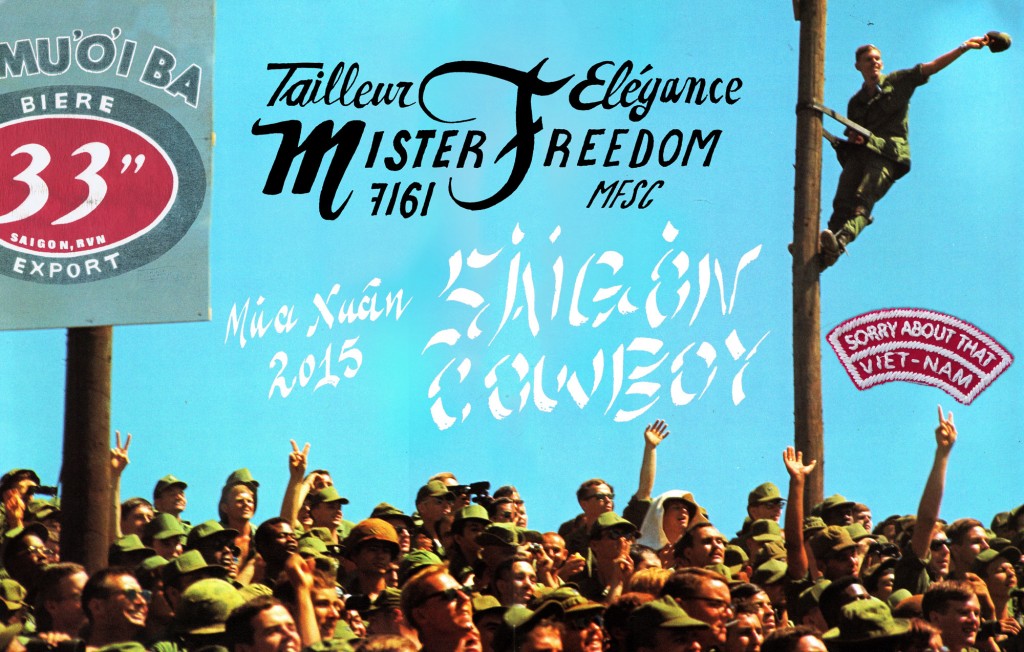
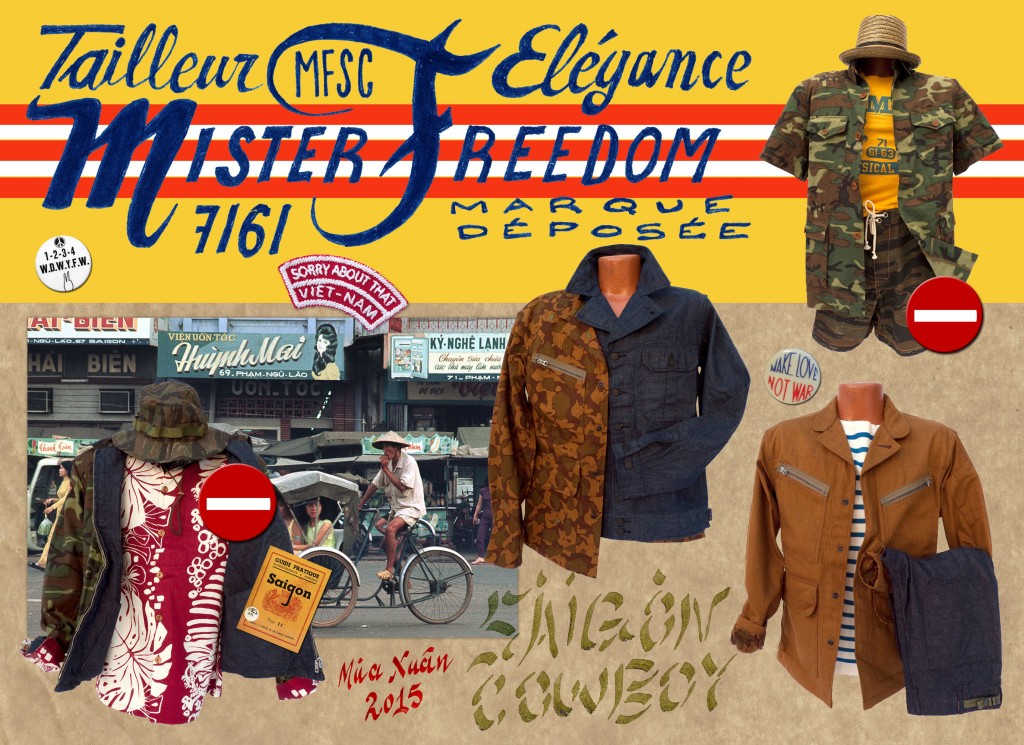
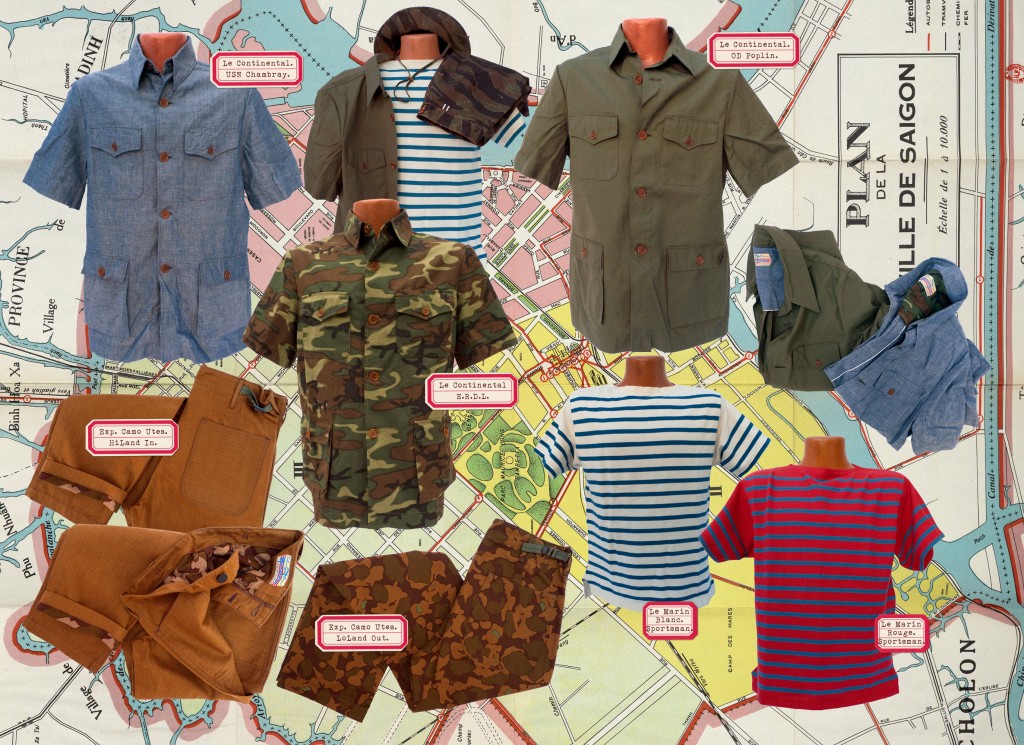
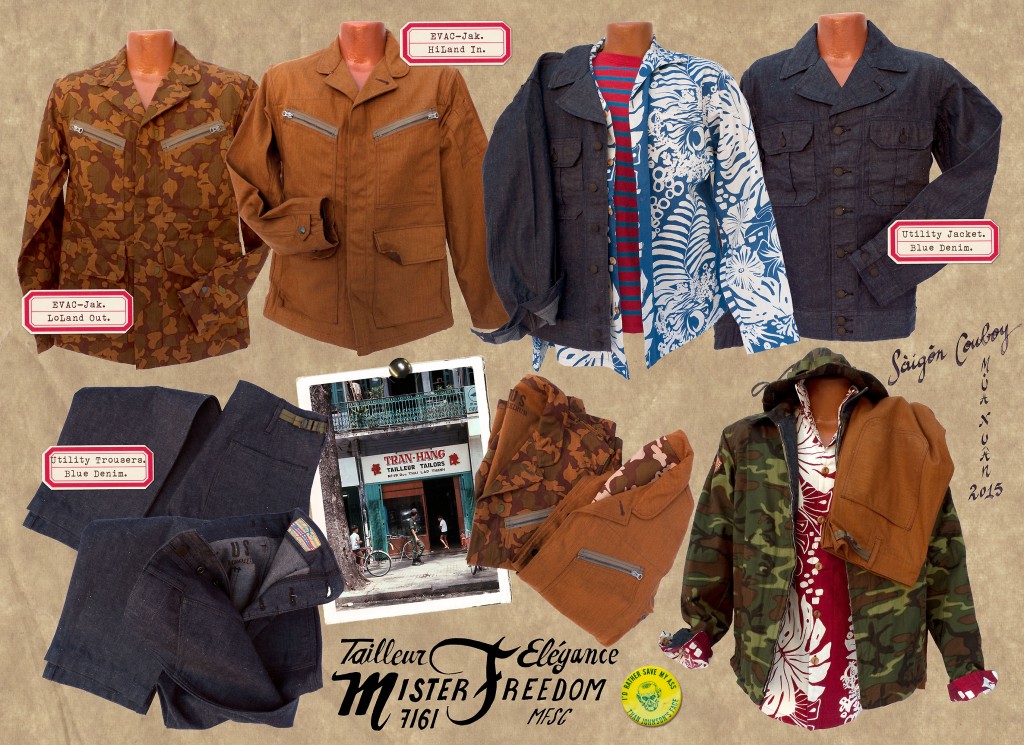
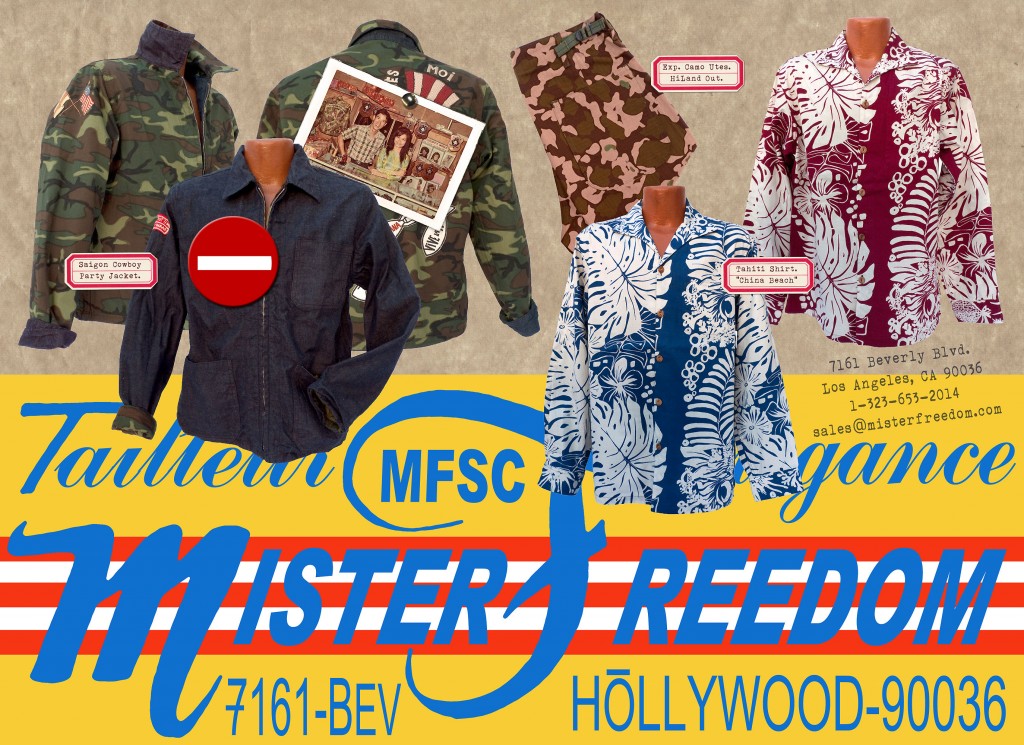
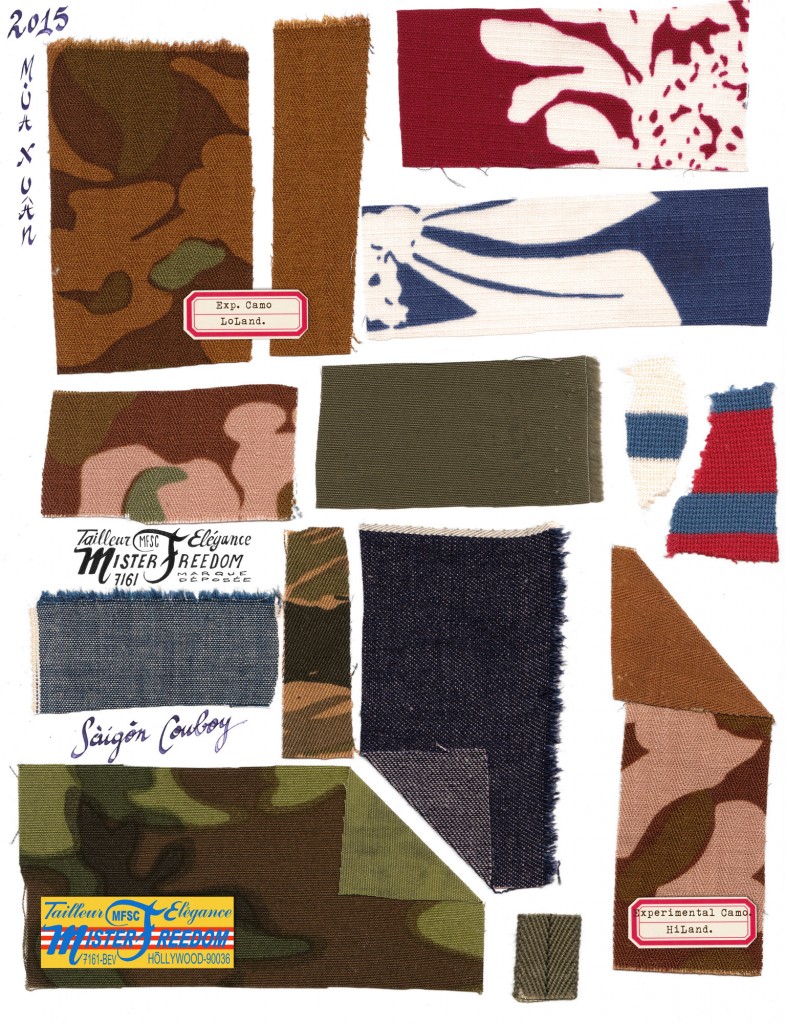
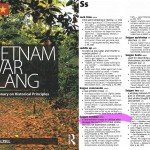
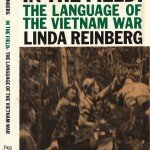
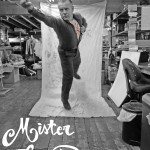


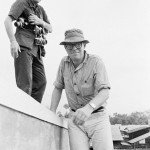

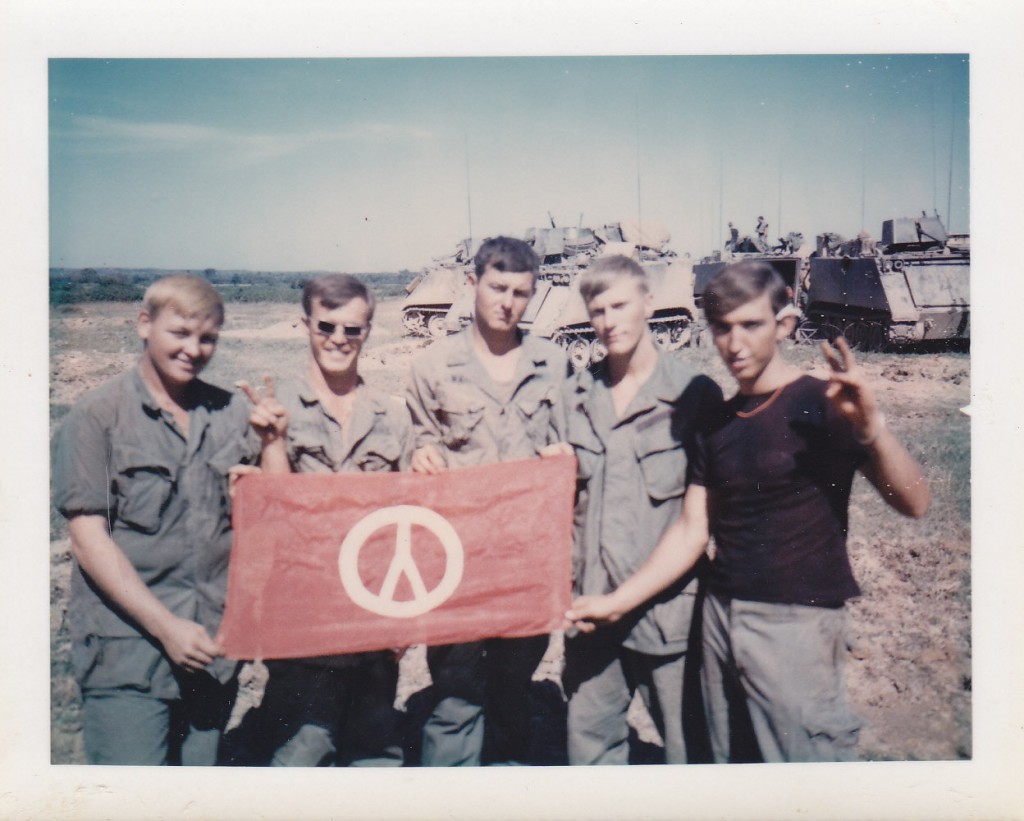
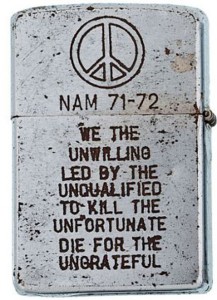
[…] War, it was an obvious choice for me to blend that jacket in the current Mister Freedom® “Saigon Cowboy” mfsc collection. I could have safely gone with apparently neutral eagles and tigers, but […]